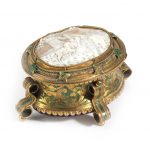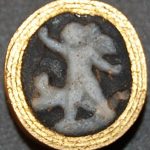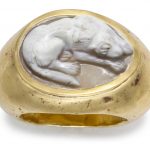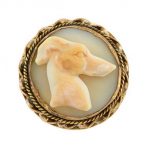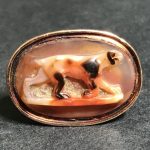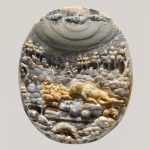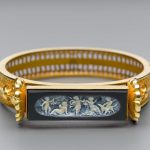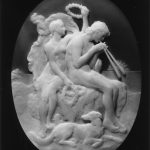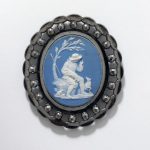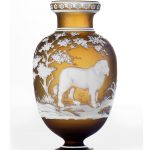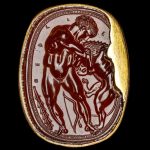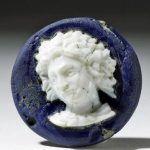Dogs have been regarded as man’s best friend for centuries and this can be seen in cameos and art. Dogs are often depicted with shepherds, children and cherubs.
The origin of the domestic dog is not clear. It is known that the dog was the first domesticated species. The domestic dog is a member of the genus Canis (canines), which forms part of the wolf-like canids, and is the most widely abundant terrestrial carnivore. The closest living relative of the dog is the gray wolf and there is no evidence of any other canine contributing to its genetic lineage. The dog and the extant gray wolf form two sister clades,with modern wolves not closely related to the wolves that were first domesticated. The archaeological record shows the first undisputed dog remains buried beside humans 14,700 years ago, with disputed remains occurring 36,000 years ago. These dates imply that the earliest dogs arose in the time of human hunter-gatherers and not agriculturists. Reference: Wikipedia
A late Victorian Continental giltmetal, green enamel and shell cameo trinket box probably Italian of oval foliate cast form with scrolling supports, the lid inset with an oval conch cameo depicting a young boy carving the name ‘Estel’ on a tree, a dog at his feet, 15cm wide
Sold for £625 inc. premium
Cameo of glass paste imitating sardonyx, engraved with Eros running to the left with his arms extended; a dog runs beside him. Roman Imperial (early) term details 1st Century -2nd Century
Reference: © The Trustees of the British Museum
A ROMAN GOLD AND AGATE CAMEO FINGER RING WITH A DOG CIRCA 2ND-3RD CENTURY A.D. The massive hollow hoop rounded on the exterior, flat on the interior, the broad shoulders set with an oval agate cameo sculpted in two layers, white on gray, with a reclining dog, its head resting on extended forepaws, the body curving with the tail extending forward along its right side, the fur along the neck, spine and right haunch delineated 1½ in. (3.8 cm.) wide; ring size 11
Sold for USD 37,500 at Christies in 2015
Antique Gold and Hardstone Cameo Dog Ring Mounting of later date, ap. 7 dwts. Size 8 1/4.
In good condition, normal wear with light surface scratches to metal. Gold rope twist mounting of a later date. Testing for 14k gold. Hardstone in good condition. Width: 1 to 3/16 inches.
Sold for $750 (includes buyer’s premium) at Doyle New York in 2017
Roman agate cameo ring of a dog, set in modern 14k gold mounting. Size 4, 4.5 dwts. Circa 2nd century AD.A wonderful example of Greek and Roman hardstone cameo carving.The dog is a pointer or bloodhound type, with the dark spots in the matrix of the stone being used as the dark spots on the dog’s ear and fur.
Sold for $800 at David Killen Gallery in 2018
Sleeping shepherdess in a moonlit landscape Alessandro Masnago (Italian, active ca. 1560, died 1620) Circa late 16th century
Gems carved with highly pictorial evocations of nature by the great virtuoso Alessandro Masnago were eagerly sought by collectors, particularly Emperor Rudolf II in Prague. The thoroughgoing artistry with which Masnago could discern the marvels inherent in a piece of stone still causes the beholder to gaze in wonder and delight at this shepherdess sleeping with her flock and her dog amid the moonbeams and treetops elicited from the hues and forms of a variegated agate, akin to moss agate.
Hinged bracelet with cameo American about 1880 Tiffany & Co.
The rectangular cameo in this bracelet is a nicolo, a carved-gem form first found in the Classical world and used for portraits and scenes of mythical and historical importance. In this nineteenth century example, the chalcedony background was stained black, creating a dramatic contrast for the white layer that the lapidary artist carved at varying depths. As a result, there is a range of tonalities with some areas having a blue-white translucence while others appear an opaque white. The scene consists of five putti, plump children with wings that first appear on child sarcophagi of the second century. Here the central figure holds a horn, two are shown holding birds, while the putto at the right restrains what appears to be a hunting dog. Similar cameos were used by Tiffany & Co. in brooches with diamond surrounds, one of which was owned by Mrs. Leland Stanford.
Reference: Museum of Fine Arts Boston
Daphnis and Chloe
This large carved cameo in onyx, a mineral in which bands of color alternate, is signed on the lower edge by its maker, Henri Louis François (1841-1896). A note in pencil on the side of the piece reads “Unfinished when died – from sculptor’s widow.” The cameo depicts the story of Daphnis and Chloe, orphaned children who grow up together and innocently fall in love. The orginal story is known from the romance written by the ancient Greek writer Longus in the 2nd century AD. The couple were popular subjects in 19th century art. François was a pupil of Bonnat and Chapu. From 1867 he exhibited cameos in various stones and at least one statuette at the Salon in Paris. These included subjects such as “Liberty,” “Saint George,” and “Prometheus,” as well as several scenes featuring Venus. He was an officer of the Legion d’Honneur and some of his work can be found in the Luxembourg Museum, Paris.
Reference: The Walter Art Museum
The Bourbonnais Shepherd Place of origin: Etruria (made) ca. 1780-1800 (made) Artist/Maker: Upton, Elizabeth Lady Templetown Viscountess Templetown, born 1747 – died 1823 (designer) Josiah Wedgwood and Sons (manufacturer)
Oval brooch of cut and polished steel, and mounted with a plaque of blue jasper-dip with a white cameo depicting a shepherd boy seated under a tree with a lamb in his arms and a dog at his feet.
Reference: © Victoria and Albert Museum
A THOMAS WEBB AND SONS STYLE TWO COLOUR CAMEO GLASS VASE of baluster form, the amber glass overlaid with carved scene of a dog by a pond in a landscape, flower head decoration to rim 14.5cm high
Sold for 8,400 AUD at Sothebys in 2007
